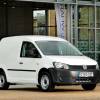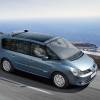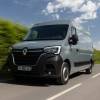
RAC sale – up to 33% off*
• Roadside cover from £5.29 a month†
• We get to most breakdowns in 60 mins or less
• Our patrols fix 4/5 breakdowns on the spot

By Andy Enright
Introduction
The Renault Kangoo van has eked a profitable niche for itself as an inexpensive city van that won't let operators down. It was first launched in 2008 but Renault never stopped developing it, two years after the model's introduction adding a lengthened 'Maxi' version to the range with a clever 'Crew Van' option. In 2011, the range was further strengthened with the LCV market's very first all-electric model. A lot then, happened to this commercial Kangoo during the 2010 to 2013 period. Here's how to track down a used example from that time.
Models
4/5dr Light panel van (1.6 petrol, 1.5 diesel, electric [Z.E., ML, ML+])
History
The second generation Kangoo arrived back in 2008, but for the purposes of this review, we're looking at the later examples built between 2010 and 2013. During this period, Renault poured a lot of attention into the development of this apparently humble panel van. The UK importers had ditched the Kangoo passenger car version at the end of 2010, but by mid-2010 the Kangoo range was already being fleshed out further with the addition of the Maxi, a long wheelbase variant that helped bridge the gap to the bigger commercials in the range, offered with 85 or 105PS versions of the 1.5-litre dCi diesel engine.
The Kangoo Z.E. Electric vehicle was also announced at the Geneva Show of 2010 and the Kangoo Maxi Z.E appeared the following year, but it wasn't until the end of 2011 that UK buyers could actually get their hands on stock. At the start of 2013, Renault announced a facelift for the Kangoo, with the big grille badge front and centre and a whole lot more high-tech features included for the price.
What You Get
The Kangoo's blocky shape affords masses of room for front seat passengers, the high ceiling creates an airy feel to the cabin and the basic dashboard design is lifted wholesale from the MK2 Scenic MPV with its two-tone finish, handle-style handbrake designed to minimise strain on the wrist and dash-mounted gear lever. Certainly, by the standards of the compact van market, quality of fit and finish is pretty good. The upright driving position also facilitates easy entries and exits. An enormous amount of headroom is present in the front of the Kangoo, enough so that all kinds of elaborate headgear could be accommodated should the occasion arise. The Kangoo comes with ABS with EBD, four load anchorage points, remote control central locking, full steel bulkhead, overhead storage shelf, driver's side airbag, height-adjustable seatbelts and steering wheel. There's also rear disc brakes and six load anchorage points. Choose the top-of-the-range ML+ and you also get a nearside side-loading door and ESP+.
What To Look For (used_look)
What You Pay
Please fill in the form here for an exact up-to-date information.
What to Look For
The Kangoo is a tough thing that can shrug off most of what even the most careless city driver will throw at it. It does ride lower than the original Mk1 and there's no all-wheel drive model, so it's not quite so clever on really bad surfaces. Check for crash damage, uneven tyre wear, kerbed alloys, parking dents, ripped or discoloured upholstery and make sure the electrical features such as central locking and sunroofs work as expected.
Replacement Parts
(approx. values for a 2010 1.5 dCi 86) A clutch assembly will be around £175 and front brake pads are around £45. An alternator should be close to £270 and a radiator around £150.
On the Road
At the wheel of a Kangoo, you sit very upright and the huge glass area gives an excellent view ahead. On country toads, there's actually a reasonable amount of grip, whilst in town, light power steering makes it easy to slot into tight spaces, although until you get used to the shape, judging the extremities of the car during parking manoeuvres can be slightly difficult as the bonnet slopes away from you.
Performance is leisurely, with even the fastest petrol and diesel models taking around 13s to reach sixty from rest on the way to 106mph. At least with the diesel, there's the compensation of prodigious torque - 240Nm of it if you go for the 105PS version, compared with just 185Nm for the equivalent petrol unit. That means fewer gear changes for diesel drivers and a much more leisurely feel. The Z.E. Feels extremely rapid off the line, although on longer journeys a heavy right boot will see the range come right down. Mind you, if you prod the eco button, the torque output is restricted to improve the range by around 10 per cent. Renault claims a range of 106 miles and its research shows 70 per cent of van drivers cover less than 62 miles in a day so the Z.E. So it might well work for you.
Overall
The Renault Kangoo van has more than deserved the success it has enjoyed. The later models are better finished than before, and the addition of the Z.E. model has been a bold move. Although the Z.E. is still very rare as a used buy, your Renault dealer might well be able to point you in the right direction. If you can score a deal on one of these, you'll have a really future-proofed van that is surprisingly simple under the skin.







